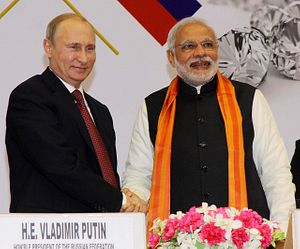Indian Prime Minister Narendra Modi met Russian President Vladimir Putin in New Delhi on Thursday for a scheduled one-day annual summit. The trend of annual bilateral leaders summits between Russia and India goes back to 2000. Each meeting alternates between New Delhi and Moscow.
This year, the talks primarily concerned the expansion of India-Russia bilateral ties in areas such as energy, trade, and defense. Putin’s visit to India also comes at a time when Russia finds itself isolated by much of the West over its support for anti-government rebels in Ukraine and its annexation of Crimea in early 2014. Additionally, with an economy facing potential long-term crisis over falling global oil prices, Putin is keen to close deals with Russia’s large Asian partners such as India and China.
As I wrote yesterday, the conditions of Modi’s meeting with Putin are somewhat complicated by India’s change in government this year and new trends in Indian foreign policy. Where India’s previous United Progressive Alliance (UPA) coalition government was content to privilege its relations with Russia over its relations with the West (especially when it came to defense cooperation), Narendra Modi’s National Democratic Alliance (NDA) coalition government has pragmatically expanded India’s cooperation on defense and other issues with the United States and other countries. In 2014, more of India’s defense imports came from the United States than from Russia.
Nevertheless, Modi wasted no time in emphasizing the longstanding and historic closeness between India and Russia. Ahead of Putin’s arrival in India, Modi turned to Twitter (lately a preferred outlet of his for diplomatic messaging), noting that while “Times have changed, our friendship has not.” He continued, “Now, we want to take this relation to the next level & this visit is a step in that direction.” “The bond between the people of Russia and India is very strong,” Modi remarked at a joint press conference with Putin. He added that India and Russia have “stood by each other through thick and thin,” alluding to Russia’s current economic circumstances and position within the global community. Additionally, to assuage Russian fears of being supplanted by the United States as India’s primary arms dealer, Modi noted, “Even if India’s options have increased, Russia remains our most important defense partner.” Modi was careful, however, not to indicate that India would ramp down its cooperation with the United States or any other countries to satisfy Russia. Putin reciprocated Modi’s rhetoric, noting that he “highly [appreciated] the friendship, trust and mutual understanding with Indian partners.”
Beyond rhetorical niceties, the two leaders oversaw the signing of a “vision” document that described a road map for India-Russia civil nuclear cooperation. According to that vision document, Russia will provide India with up to 20 nuclear reactors going forward. For the moment, Rosatom, Russia’s state-owned nuclear energy corporation, is committed to supplying India with 12 nuclear reactors over the next two decades. India and Russia are already cooperating on the 1,000-megawatt Kudankulam nuclear power station, though the project has encountered delays and setbacks. Meanwhile, Rosneft, a major Russian state-owned oil company, signed a 10-year crude supply deal with India’s Essar Oil.
On defense, the two leaders stated their commitment to move ahead with plans for a jointly developed fifth-generation fighter. India and Russia had run into some disagreement on this issue in the past over Indian demands for greater inclusion in the development process. The two will also cooperate on developing a multi-role transport aircraft. Finally, India will assemble 400 Russian multi-role helicopters every year. This deal is especially significant as it will help India build its indigenous defense production capacity while modernizing the country’s aging helicopter fleet.
As expected, the visit emphasized the continuing importance of the bilateral relationship for both sides. While the Modi government has enthusiastically and dynamically advanced India’s relations with other countries, this hasn’t come at the expense of its relationship with Russia. Despite the change in government, many of India’s old guard, even within the Bharatiya Janata Party (BJP), acknowledge Russia’s role as a historic benefactor and friend to India. Owing to this legacy, India continues to stand as one of Russia’s reliable partners in Asia. Notably, as several Western nations came together to sanction Russia for its actions in Ukraine, India refrained from any negative action against Moscow.
Russia, for its part, recently upset India with its decision to conclude a deal for the sale of Mi-35 helicopters to India’s South Asian rival, Pakistan. While Russia has a set of valid geopolitical reasons that have nothing to do with India for approaching Pakistan on defense matters, there’s been speculation that the move is a tit-for-tat response spurred by the United States increasing its defense cooperation with India.

































